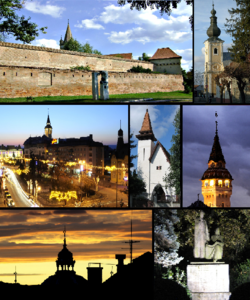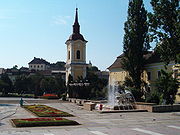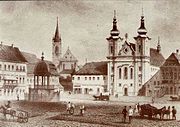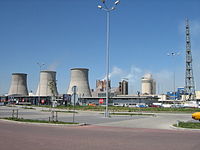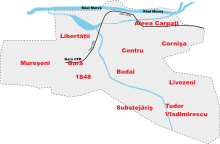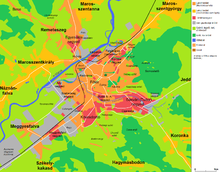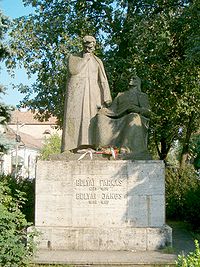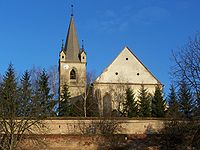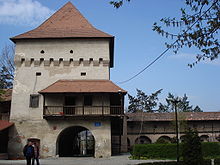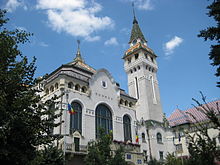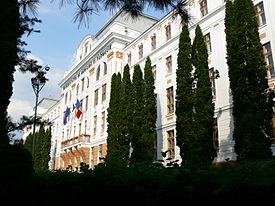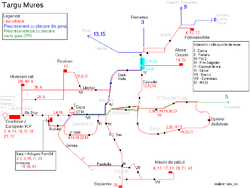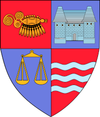- Târgu Mureș
-
Târgu Mureș
Marosvásárhely— City — Târgu Mureș 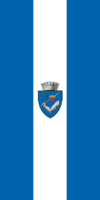
Flag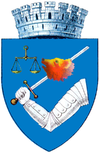
Coat of armsLocation of Târgu Mureș in Romania Coordinates: 46°32′44″N 24°33′45″E / 46.54556°N 24.5625°ECoordinates: 46°32′44″N 24°33′45″E / 46.54556°N 24.5625°E Country  Romania
RomaniaCounty  Mureş
MureşStatus County capital Government – Mayor Dorin Florea (Democratic Liberal Party) Area – Total 49.3 km2 (19 sq mi) Population (January 1, 2009[1]) – Total 145,151 – Density 2,944/km2 (7,624.9/sq mi) Ethnicity[2] – Romanians 50.4% – Hungarians 46.7% – Gypsies 2.4% Time zone EET (UTC+2) – Summer (DST) EEST (UTC+3) Postal Code 540xyz1 Area code(s) +40 x652 Car Plates MS-N3 Website http://www.tirgumures.ro/ 1x, y, and z are digits that indicate the street, part of the street, or even the building of the address
2x is a digit indicating the operator: 2 for the former national operator, Romtelecom, and 3 for the other ground telephone networks
3used just on the plates of vehicles that operate only within the city limits (such as trolley buses, trams, utility vehicles, ATVs, etc.)Târgu Mureș (Romanian pronunciation: [ˈtɨrɡu ˈmureʃ]; Hungarian: Marosvásárhely pronounced [ˈmɒroʃvaːʃaːrhɛj] (
 listen); German: Neumarkt am Mieresch) is the seat of Mureș County in the north-central part of Romania. As of January 1, 2009 the city had a population of 145,151 inhabitants,[1] making it the 16th most-populated city in Romania.
listen); German: Neumarkt am Mieresch) is the seat of Mureș County in the north-central part of Romania. As of January 1, 2009 the city had a population of 145,151 inhabitants,[1] making it the 16th most-populated city in Romania.Contents
Names and etymology
 A trilingual town sign in Târgu Mureș. Note the presence of both the older Romanian spelling Tîrgu Mureș and the newer Târgu Mureş (but with an s cedilla rather than s comma. Marosvásárhely is the Hungarian name and Neumarkt am Mieresch, German.
A trilingual town sign in Târgu Mureș. Note the presence of both the older Romanian spelling Tîrgu Mureș and the newer Târgu Mureş (but with an s cedilla rather than s comma. Marosvásárhely is the Hungarian name and Neumarkt am Mieresch, German.
The current Romanian name of the city, Târgu Mureș, is the equivalent of the Hungarian Marosvásárhely with both meaning "market on the Mureș (Maros) [River]" In Romanian, târg means "market" and, in Hungarian, vásárhely means "marketplace". The Hungarian is Marosvásárhely is sometimes shortened to Vásárhely.
The first written reference to the city was in the Latin Novum Forum Siculorum in 1332 followed by mention as Sekulvasarhel (modern Hungarian: Székelyvásárhely), meaning "new market of the Székelys", in 1349.[citation needed] Other Latin names for the town included Agropolis and Areopolis.
In 1616, Gabriel Bethlen gave the name Marosvásárhely to the newly upgraded royal free city. The Romanian name for the city, Oşorhei was a phonetic derivation from Vásárhely while the German name for the town, Neumarkt am Mieresch (also shortened to Neumarkt or Marktstadt; in Transylvanian Saxon, Nai Mark or Nai Muark), is a translation of Marosvásárhely.
Other historical Romanian names for the town besides Oșorhei were Mureș-Oșorhei and Târgul Mureșului; other historical Hungarian names in addition to Székelyvásárhely included Újszékelyvásár and Újvásár.[citation needed]
After World War I, Marosvásáshely became part of Romania and was renamed Oșorheiu.[citation needed] The name Târgu Mureș became common in the interwar period. After, World War II, the spelling of the city's name was changed to Tîrgu Mureș following a 1953 spelling reform that replaced the letter â with î in all words.
Another spelling reform in 1993 replaced the letter î with â in many words and the city has been officially spelt "Târgu-Mureș" since although the pre-1993 spelling of "Tîrgu Mureș" continues to appear. Both forms are also at times spelt with a hyphen between the two words (and with an s cedilla [ş] instead of the typographically correct s comma [ș]).
History
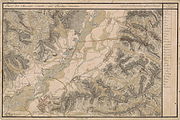 Marus-Vasarhely on the Map of Joseph II
Marus-Vasarhely on the Map of Joseph II
 The city centre in 1911 with the musical fountain of Péter Bodor
The city centre in 1911 with the musical fountain of Péter Bodor
 György Bernády
György Bernády
The city was first documented in 1332 in the papal registry under the name Novum Forum Siculorum, and as Sekulvasarhel (Székelyvásárhely) in 1349. On the place of its Castle Church, the Dominican's church stood until the Mongol invasion, when it was destroyed. In its place, the Franciscans built a new Gothic church in 1260, which was completed in 1446. Since 1439 the town was the scene of the session of parliament ( diet) 36 times. In 1405, the King of Hungary Sigismund of Luxembourg granted the city the right to organize fairs. In 1470 King Matthias Corvinus granted the first judicial privilege to the city, and in 1482 declared the city a royal settlement. In 1492, wayvoda István Báthory strengthened its monastery with fortifications, this was a pentagon-shaped outer castle tower. In 1506, the troops of Pál Tomori were beaten by the Szeklers rising against the payment of an extraordinary Ox tax imposed on them on occasion of the birth of Louis II of Hungary. In 1557, the Reformed Church College (i.e. Presbyterians) was established as the oldest Hungarian school of Transylvania. In 1571, the session of Transylvanian parliament under prince John II Sigismund Zápolya accepted the free preach of the word of God, including the Unitarian Church. In 1600-1601, as a result of the siege of Giorgio Basta, the fortress turned to ruins.[3] In 1602, the troops of Gergely Németh put on fire the remaining houses of the town, therefore, in 1602 the reconstruction of the fortress was started further the advice of mayor Tamás Borsos, but it was actually built between 1614 and 1653. Mózes Székely the only prince of Szekler origin visited the city in 1603, when liberated Transylvania from foreign domination. In 1616, it was granted the status of a free royal city under the name of Maros-Vásárhely by prince (fejedelem) Gábor Bethlen.[3] In 1658, Turkish and Tartarian troops invaded and burned it, 3000 people were taken into captivity. In 1661, as no one show willingness to accept the duty of prince, under pressure from pasha Ali, Mihály Apafi was elected prince here. In 1662, resulting from the negligence of the Turkish military residing here, the city was almost completely burnt down. In 1687, it was devastated by German imperial troops.
In 1704, the kuruc troops of Pál Kaszás occupied the fortress, which was re-occupied by Lőrinc Pekry from the labanc in 1706. On 5 April 1707, Francis II Rákóczi was raised to the chair of princes. In 1707 it was struck by pest, more than 3500 people died, the black death renewed in 1709, 1719 and in 1738-39.[3] The city received a major boost to its social and economic life when it became home to supreme court of justice of the Principality of Transylvania in 1754. In 1802, the Teleki Library founded by count Sámuel Teleki was opened for the public with 40.000 volumes.[4]
Avram Iancu, the leader of the 1848 Romanian revolution in Transylvania, was a young lawyer in the city of Marosvásárhely before engaging in the fight for the rights of Romanians living in Transylvania. On 4 November 1848, the Szekler troops were beaten by the Austrian imperial troops under its walls, and the city was also captured. On January 13, 1849 the troop of major Tolnay recaptured it. On 30 July 1849, Sándor Petőfi and Bem set out from here for the Battle of Segesvár.
In 1854, Szekler martyrs Károly Horváth, János Török and Mihály Gálfi were executed on the Postarét for plotting against the Austrian rule,[3] since 1874 a monument marks the place. In 1861, Marosvásárhely became the seat of Marosszék, in 1876 that of Maros-Torda County. In 1880 the statue of Bem was inaugurated in Roses Square, in downtown area; in 1893 the statue of Kossuth was as well. The statue of Rákóczi was also inaugurated in 1907. All three were demolished after World War I between 1919 in 1923 after Transylvania became part of Romania.
The provincial appearance of the city changed greatly in the late 19th century and early 20th century. In 1913, the Hungarian Art-Nouveau style city hall complex and Cultural Palace was opened, as part of mayor Bernády György's urban renewal.[citation needed] After World War I, together with the rest of Transylvania, Marosvásáshely became part of Romania and was re-named Oşorheiu. From having been an 89% Hungarian-populated city (1910), Romanian population increased throughout the latter half of the 20th century.
From 1940 to 1944, as a consequence of the Second Vienna Award, the city was ceded back to Hungary. After Hungary was occupied by Germany in 1944, a Jewish ghetto was established in the city. Oşorheiu re-entered the Romanian administration at the end of the war in October 1944, however, on 12 November 1944 General Vladislav Petrovich Vinogradov of the Soviet Red Army expulsed the returning Romanian authorities from Northern Transylvania with reference to the massacres committed by members of Iuliu Maniu's so-called Maniu Guard, and the Romanian authorities were not allowed to return until the government of Petru Groza was formed on 6 March 1945.[5]
After World War II, the communist administration of Romania conducted a policy of massive industrialization that completely re-shaped the community. Between 1950-1968, it was the center of the Hungarian Autonomous Province, later named as Mures-Hungarian Autonomous Region. On 7 September 1959, Gheorghe Gheorghiu-Dej, Secretary-General of the Romanian Workers Party, and the Prime Minister Chivu Stoica visited the city.[citation needed] It was then decided where to build the fertilizer production plant, and the new residential quarters of the city. It was decided that the residential quarters would not be built in the Maros valley, but on the surrounding hills.
In March 1990, shortly after the Romanian Revolution of 1989 overthrew the communist regime, the city was the scene of violent ethnic clashes between ethnic Hungarians and ethnic Romanians.
As of 2000,[citation needed] a considerable percentage of its population has started to work abroad temporarily. The local economy has started to get stronger after various investors settled in the area.
The city has a substantial ethnic Hungarian minority, some of whom identify as Székelys. Since 2003,[citation needed] some Székely organizations have been campaigning for the city to become the center of an autonomous region again.
Geography
Târgu Mureş is is located in the Mureş River valley. The city spreads out from Fortress Church in the center of the town, built in the 14th century, to form an area of 49.3 square kilometres (19.0 sq mi). The city is located at the centre of the historical region of Transylvania and covers an area of 49.3 square kilometres (19.0 sq mi). It lies at the junction of three geographical regions of Transylvania (Transylvanian Plain, Mureş Valley and Niraj Valley) at 330 meters above sea level. The city extends onto both banks of the Mureş river, however, the downtown area and the greater part of the districts are located on the left bank. The Corneşti-plateau ( Hungarian: Somos-plateau) is the city's highest point (465 metres (1,526 ft) above sea level, co-ordinates: 46°33′11″N 24°35′54″E / 46.5531°N 24.5984°E).
Târgu Mureş is 346 kilometres (215 mi) from Bucharest, 480 kilometres (300 mi) from Belgrade, 515 kilometres (320 mi) from Budapest and 598 kilometres (372 mi) from Sofia. It is surrounded by the following communes: Sângeorgiu de Mureş, Livezeni, Sântana de Mureş , Sâncraiu de Mureş, (Corunca), Cristeşti, Ceuaşu de Câmpie. Two villages, Mureşeni (Meggyesfalva) and Remetea (Remeteszeg), are administered by the city.
Distances between the city and some of the major cities in Romania:
- Bucharest: by rail 448 km, by road 346 km
- Braşov by rail 282 km, by road 171 km
- Cluj-Napoca 127 km by rail, by road 105 km
- Sibiu by rail 189 km, by road 124 km
Climate
Târgu Mureş has a continental climate characterised by warm dry summers and relatively cold winters. Winter temperatures are often below 0 °C (32 °F). Throughout the year there are 38 days with snow, and more than 60 days when the snow covers the ground. In summer, the average temperature is between 18 °C (64 °F) and 19 °C (66 °F) (the average for June, July and August), even though temperatures sometimes reach 36 °C (97 °F) during this period. On average, there are 143 days with precipitation over the course of the year, most frequently in December with 16 days and the least in August, September and October with 8 rainy days. The average annual temperature for Târgu Mureş is 8.6 °C (47 °F). The record minimum temperature registered in the city was −32.8 °C (−27 °F) in the years 1942 and 1963. The record maximum temperature of 39 °C (102 °F) was recorded in 1936. Temperatures over the last 14 years:
Climate data for Târgu Mureş Month Jan Feb Mar Apr May Jun Jul Aug Sep Oct Nov Dec Year Record high °F (°C) 54
(12)63
(17)77
(25)79
(26)88
(31)91
(33)97
(36)91
(33)90
(32)79
(26)66
(19)63
(17)97
(36)Average high °F (°C) 30
(−1)34
(1)50
(10)59
(15)68
(20)72
(22)75
(24)75
(24)70
(21)59
(15)43
(6)30
(−1){{{year high F}}}
(13)Average low °F (°C) 21
(−6)23
(−5)32
(0)41
(5)50
(10)54
(12)57
(14)55
(13)50
(10)39
(4)32
(0)27
(−3){{{year low F}}}
(4)Record low °F (°C) −18
(−28)−22
(−30)0
(−18)23
(−5)32
(0)36
(2)45
(7)41
(5)32
(0)19
(−7)0
(−18)−6
(−21)−22
(−30)Avg. rainy days 15 12 13 14 13 13 11 8 8 8 12 16 143 Source: Weatherbase.com[6] Demographics
According to the 2002 census data,[7] the city had a population of 149,577. Among them 69,825 are Hungarians forming the largest urban Hungarian community in Romania, surpassing that of Cluj-Napoca. The 2002 census was the first to show the Hungarians as a local minority. The city is officially bilingual and both Romanian and Hungarian languages are recognised as official and used in public signage, education, justice and access to public administration, however, in case of commercial signage and advertisements the bilingual signage is usually used only by companies if they are owned by Hungarians. Roma people make up 2.51% of the city's population which is considerably lower than their proportion of 6.96% in Mureş County.
Ethnic communities
Ethnic structure evolution from 1850 till 2002:[8]
Year Total Romanians Hungarians Germans Jews Roma Others 1850 7,855 6.0% 82.6% 3.1% 2.6% 3.6% 2.1% 1869 12,678 5.2% 88.9% 3.5% n.a. n.a. 2.4% 1900 20,229 11.6% 83.3% 3.6% n.a. n.a. 1.5% 1910 25,517 6.7.% 89.3% 2.4% n.a. n.a. 1.6% 1930 40,058 26.7% 57.2% 1.7% 12.1% 1.1% 1.2% 1966 86,464 28.3% 70.9% 0.6% n.a. n.a. 0.2% 1977 127,783 34.8% 63.6% 0.6% 0.4% 0.5% 0.1% 1992 164,445 46.1% 51.4% 0.3% 0.1% 2% 0.1% 2002 149,577 50.4% 46.7% 0.2% n.a. 2.4% 0.01% Year Total Romanians Hungarians Germans Jews Roma Others 2002 149,577 75,317 69,825 275 n.a. 3,759 401 Religious communities
The largest religious community in Târgu Mureş is Romanian Orthodox, numbering 46.74% of the population. The most significant other religious communities are Hungarian Reformed (30.06%), Roman Catholic (13.50%), Eastern Catholic (2.60%), and Unitarian (2.58%).
Economy
At present in Târgu Mureş there are over 8500 private companies and also a few state-owned companies.[9]
The various industrial sectors are:
- Chemical industry (Azomureş)
- Food industry:
- Bread industry (Mopan)
- Dairy industry
- Wood industry
- Textile industry
- Leather industry
Districts of the city
in Romanian in Hungarian Centru Belváros Dâmbul Pietros (1848) Kövesdomb (1848) Unirii (on the right of the Mureş River) Egyesülés ( i.e. Benefalva and Hídvég villages on the right of the Maros River)
Rovinari (Ady Endre) Ady Endre Aleea Carpaţi Kárpátok sétánya (former: Hungária) Budai Nagy Antal Budai Nagy Antal Gara Állomás Livezeni Jedd 1989 December 22 (November 7) 1989 December 22 (November 7) Tudor Vladimirescu Sásvári-negyed (Tudor Vladimirescu) Răsăritului Kikelet Mureseni Meggyesfalva Substejăriş Cserealja Cornişa Kornisa Valea Rece Hidegvölgy Personalities
Many personalities have been born or lived in the city and helped shaping it in different fields:
- Tamás Borsos (1566-after 1633)
- Péter Apor (1676–1752)
- Gheorghe Şincai (1754–1816)
- György Aranka (1737–1817)
- Petru Maior (1756–1821)
- Sámuel Teleki (1739–1832)
- Farkas Bolyai (1775–1856)
- Avram Iancu (1824–1872)
- Alexandru Papiu Ilarian (1827–1877)
- János Bolyai (1802–1860)
- György Bernády (1864–1938)
- József Dudás (1912–1957)
- János Kemény (writer) (1903–1971)
- Károly Molter (writer) (1890–1981)
- András Sütő (writer) (1927–2006)
- Gabriel Herman (History professor at the Hebrew University of Jerusalem, born 1947)
The city was the home of composer György Orbán (born 1947), SMURD doctor Raed Arafat (born 1964) and football player László Bölöni (born 1952).
Main sights
Main article: List of places in Târgu MureşPlaces of worship
The Reformed Fortress Church is the oldest church in the town. According to historical evidence, less than a century had passed after the first appearance of the Franciscan order in Transylvania, Hungarian Kingdom, that the Franciscan friars arrived to Marosvásárhely. The building of the church took an entire century, from the middle of the 14th century until the middle of the 15th and it consisted of a monastery building, an older chapel, the church and the steeple. The church was finalized between 1400 and 1450. The church may have been originally decorated with frescos, as traces of mural paintings were found inside. The almost complete disappearance of these paintings is due to the fact that the church became the property of Protestant believers in 1557. The religious reform required for churches to have no paintings, statues or religious frescos.
The existence of the Franciscan order in Marosvásárhely was directly affected by the religious reform which was largely spread in Transylvania during the 16th century. In 1557, the influence of the Reformed Church over the Hungarians in the town was so strong that it eventually led to the confiscation of the properties of Catholic monastic orders. Franciscan monks, who until that time had been attending the church in the fortress, were forced to leave town. They returned after nearly two centuries when the political climate had become favorable to Catholicism due to the instauration of the Habsburgs in Transylvania. They bought the land in the center of the town where they built a new church and monastery by 1777. The tower, the only part that is still standing, was added to the church's facade in 1802 by architect János Topler. In 1971 the municipality decided to demolish the monastery to create the necessary space for the construction of the National Theater and the square in front of it. A new church was built for the Franciscans on Libertăţii street.
At the beginning of the 18th century, one of the most representative Baroque churches of Transylvania was built in the town. St John the Baptist Church was erected in the North-Eastern part of the city center and belongs to the Roman Catholic parish. The inside of the church is luxurious, with liturgical objects that are true works of art. The main altar, made in 1755 by Anton Schuchbauer and Johannes Nachtigal is of monumental dimensions and has a pseudo-architectural structure. The paintings of the altars in the lateral chapels: Saint Ladislaus I of Hungary, Saint Joseph, Saint John of Nepomuc, Holy Cross belong to the same Michael Angelo Unterberger. The stained glass windows made by the Türke Company of Grottau were installed in 1898.
The Big Synagogue was built between 1899 and 1900 at the initiative of the Jewish community "Status Quo" and that was considered to be one of the most beautiful synagogues of the Austro-Hungarian Empire. The design of the building was drawn up by Gartner Jacob from Vienna and the construction works were coordinated by the Hungarian Pál Soós. The entire edifice is dominated by the central cupola. Each side of the central spire is decorated with a floral rosette similar to the ones on the facade. This type of window is also used several times on the lateral facades. The vast interior is richly decorated, both with shapes and color. The synagogue has 314 seats on the ground floor and 238 on the top floor. The most recent large scale remodeling of the building took place in 2000 when the walls were reinforced and the interior decoration was re-done.
The existence of the Unitarian faith in the town is linked to the name of Ferenc Dávid, founder of Unitarianism and the first Unitarian bishop. The political circumstances in Transylvania became favourable for Ferenc Dávid’s activity as the Diet of Torda held between 1557 and 1568 granted freedom of faith to all religions in Transylvania. The Unitarianism became religio-recepta together with all the other Protestant faiths. The king of the state himself, John II Sigismund Zápolya became Unitarian. The Unitarian Church was built between 1929 and 1930 next to the old Unitarian prayer house dating from 1869.
Other sights
The old City Hall now is the residence of the Mureş County Council.
 The Cultural Palace built between 1911 and 1913.
The Cultural Palace built between 1911 and 1913.
The first fortress in the town was erected in 1492 upon order of Transylvanian voivode Stephen Báthory, and was accomplished somewhere between 1602 and 1652 under judge Tamás Borsos. Having a pentagon plan, surrounded by a defense wall, the Citadel has seven forts, five of them bearing the names of the guild which – according to tradition – supported its maintenance: the leather dressers’, the tailors’, the butchers’, the ironmongers’, the coopers’. After the Citadel was taken over by the Austrian troops, it became the headquarters of the military garrison based in the town. In the mean time the Baroque style building was built (on the left hand side of the road in front of the entrance gate) and in the second half of the 18th century the construction works of the "barkey" were started, an addition finished in the 19th century. On the occasion of the Târgu_Mureş days – which have as central point of performance the Citadel – a museum center was opened in the gate fort (erected in 1613) presenting the history of the town and of the Citadel.
The Teleki-Bolyai Library is a historic public library and current museum in the town. One of the richest Transylvanian collections of cultural artefacts, it was founded by the Hungarian Count Sámuel Teleki in 1802, at the time when Transylvania was part of the Habsburg Monarchy, and has been open to the reading public ever since. It was among the first institutions of its kind inside the Habsburg-ruled Kingdom of Hungary. It houses over 200,000 volumes, of which many are rarities, constituting a comprehensive scientific database. The book collection is divided into several smaller libraries, of which the two main donations are the original 40,000-volume Teleki Library and the 80,000-volume Bolyai Library; the rest, grouped as the Miscellaneous Collection, is made up of several private libraries, volumes previously held by religious schools and those of a Franciscan monastery. Overall, the library constitutes a collection of most traditional types of Transylvanian book.
The old City Hall was built in 1906-1907 after the construction plans of Komor Marcell and Jakab Dezső. The entrance area, including the corridor and the staircase leading to the first floor, is the most representative in this regard. The ribbed stellar vaults that cover this area were inspired by Gothic architecture. The vaults are supported by columns with composite caps, and the keystone is a large floral shape which includes the lighting appliance. The vaults are painted with spiraling vegetal motifs. Elements of the front hall include the stone bench with its legs shaped as those of an animal and with wing-shaped handles. Its shell-shaped, golden back has a shield flanked by two volutes on its upper side. Features of the monumental staircase leading to the first floor include the upper side of the banister resembling a slithering animal or a wave. The exterior decoration is simpler and is based on Hungarian-Székely folk motives made of polychromatic ceramics. The ground floor is marked by a solid, embossed pedestal. Windows with large openings tend to be predominant in the facade. The three semicircular windows in the middle area of the facade are those of the honor hall that has a double elevation with respect to the other rooms. The glass paintings which illustrated Gábor Bethlen, Francis II Rákóczi, Lajos Kossuth, Ferenc Deák and Franz Joseph I of Austria are missing from the halls.
The Cultural Palace is a remarkable construction in the city center. It was built upon initiative of the mayor of the town, György Bernády. Building works started in the spring of 1911. They contributed to the establishment of the Hungarian secessionist architecture school in Transylvania by their works in Deva and Oradea. The plan is an irregular rectangle, with protuberances on the sides and at the extremities. The building has five floors: a tall ground floor, a mezanine and three floors differentiated by the use of various construction materials. The facades are characterized by bi-dimensionality and by a liniar-rectangular style, with only a few curvilinear elements: the six bow-windows covered by semi-caps above the main portal and the circular balconies on the edges. The main entrance is in the middle of the facade on Enescu street and is made up of four massive doors, protected by an architectural element made of glass and with an iron framing. This element, as well as the doors decorated with iron floral motifs are typical for the early 20th century style. The exterior is richly decorated, with colored mosaic panels, with relieved scenes and busts of Hungarians. The mosaic on the main facade is an allegorical scene inspired by the Hungarian folklore. The cardboards were made by Nagy Sándor, a Hungarian artist, who founded with Körösföy Kriesch Aladár the School of Gödöllő. The art is characterized by bi-dimensionality and vertical rhythmicalness. Most of the mosaics and stained glass windows were authored by Róth Miksa, particularly those on the side facing Square.
The Cornesti high (Somostető), a landscape of Târgu Mureş, can be seen from here.
Culture
The city is home to the Peninsula / Félsziget Festival, Romania's biggest music festival
Politics
The local Municipal Assembly has 23 members divided into 5 political parties:[10]
Party Number of councillors Democratic Union of Hungarians in Romania 10 Democratic-Liberal Party 8 Social Democratic Party 2 National Liberal Party 2 Greater Romania Party 1 Education
Târgu Mureş is an important centre for general and higher education. The most important high schools are the "Colegiul Naţional Alexandru Papiu Ilarian" and the Hungarian-speaking "Bolyai Farkas High School". The latter is a continuator of the traditions of the Schola Particula, established in Târgu Mureş in 1557, and of the Reformed College banished from Sárospatak at the beginning of the 18th century . The establishment was one of the first schools of the Reformed Church in Transylvania, was first working in the old building of the Franciscan monastery in the fortress, and had Baranyai Decsi, Czimor Janos, Tordai Adam, Laskoi Csokas Peter as teachers, as well as others. After being sacked in 1601 and 1602, the Schola was moved into another building, on the place of the present high school. For centuries it had accommodated the Reformed College and the present high school. The present aspect was acquired at the end of the 19th and the beginning of the 20th century. The main statue, facing Bolyai square was erected following the design of architect Baumgarten Sandor in 1908-1909, in Hungarian Secession style.[11]
Renowned universities like the University of Medicine and Pharmacy, Petru Maior University and Sapientia University account for more than 10,000 students between them. The Sapientia – Hungarian University of Transylvania is an institution of Hungarian higher education in Transylvania. Its establishment was motivated by needs outgrowing the present choice of Hungarian university education in Romania,[citation needed] especially that the percentage of Hungarian students in Romanian university life does not represent the percentage of Hungarian population in the country,[citation needed] and university education in Hungarian does not cover the range of necessary specializations.[citation needed] Other universities are the Theatre University and Dimitrie Cantemir University.
Health care
Târgu Mureş has a well-developed healthcare system. It consists of:
- 2 hospitals
- A County hospital (the biggest in the county) with 11 specialized units
- A Municipal hospital with 7 specialized units
- 36 medical offices
- 9 clinics
- Over 80 pharmacies
- Ambulances and SMURD
Transport
Transylvania Motorway (also known as A3), which is due to be completed in 2013, will pass near Târgu Mureş. Another future highway that will be connected with the city is the East-West Motorway (A4), that will start in the eastern part of the country near Iaşi, Moldavia and will connect itself with A3. It is due to be completed in 2015.
Târgu Mureş standard gauge railway station is served mainly by the State Railways route 405, and by the private operator S.C. Transferoviar Grup S.A. (route 300/405). A tourist narrow gauge line (which formed part of an extensive narrow gauge system closed in the 1990s)to Band is operated at certain times of the year.
The city is served by Târgu Mureş International Airport, which provides both domestic and international flights. It was renovated in October 2005. The airport is the third busiest airport in Transylvania, after Cluj-Napoca International Airport and Sibiu International Airport.[12]
The city transport operators are S.C. Transport Local S.A., S.C. Siletina-Impex S.R.L. and S.C. TudorTrans S.R.L..
Sports
The city is represented in many sports, including: football, handball, basketball and volleyball.
Târgu Mureş is the home city of two football teams: FCM Târgu Mureş, which plays in Liga I, and Gaz Metan Târgu Mureş, who competes in Liga III.
Târgu Mureş is also known for its bowling team, Electromureş.
The most followed sport in the city is basketball, which is enjoying a huge audience with thousands of fans, with the team BC Mureş playing in the first division. They play their home matches at the "Sala Sporturilor" (Sports Arena in English).
Local media
- Printed media
- Népújság
- 24 de ore mureşene
- Vásárhelyi Hírlap
- Cuvântul liber
- Zi de zi
- Központ (weekly paper)
- Ziarul de Mureş (weekly paper)
- Infomaţia de Mureş (weekly paper)
- Flash (weekly advertisement)
- Piaţa Mureşeană (weekly advertisement)
- Mediatica.ro
- EuroMaros.ro
- kakukk.ro
- Radio
- Radio Târgu Mureş / Marosvásárhelyi Rádió
- Rock FM
- Kiss FM
- Radio GaGa
- Radio 21
- Magic FM
- Europa FM
- Television
- TVR Târgu Mureş
- Ştii TV
- Mureş/Maros TV
- Erdélyi Magyar Televízió
- Realitatea TV Târgu Mureş
- Duna TV Marosvásárhely
- Antena 1 Târgu Mureş
- Prima TV Târgu Mureş
- ProTV Târgu Mureş
Twin towns — sister cities
See also: List of twin towns and sister cities in RomaniaTârgu Mureș has 9 twin towns and sister cities, as listed below:
 Ilmenau, Germany
Ilmenau, Germany Baja, Hungary
Baja, Hungary Kecskemét, Hungary
Kecskemét, Hungary Szeged, Hungary
Szeged, Hungary Újbuda, Budapest, Hungary, since 1997[13]
Újbuda, Budapest, Hungary, since 1997[13] Zalaegerszeg, Hungary, since 1996 [14]
Zalaegerszeg, Hungary, since 1996 [14] Güzelçamlı, Turkey
Güzelçamlı, Turkey Bournemouth, United Kingdom
Bournemouth, United Kingdom East Renfrewshire, United Kingdom
East Renfrewshire, United Kingdom
See also
- List of Hungarian exonyms (Mureş County)
References
- ^ a b "Populaţia stabilă la 1.01.2009" (in Romanian). INSSE. May 19, 2009. http://www.insse.ro/cms/rw/resource/populatia%20stabila%20la%201%20ianuarie%202009%20si%2018.xls?download=true. Retrieved May 20, 2009.
- ^ "Romanian census 2002". Edrc.ro. http://www.edrc.ro/recensamant.jsp?regiune_id=2568&judet_id=2699&localitate_id=2700. Retrieved 2011-11-18.
- ^ a b c d Balázs Orbán. "Székelyföld Leírása (The description of Szeklerland)". Mór Ráth. http://mek.oszk.hu/04800/04804/html/166.html. Retrieved 2009-10-25.
- ^ "Teleki-Bolyai Könyvtár (". 2009-10-25. http://www.telekiteka.ro/index.php?m=teleki_bolyai_konyvtar.
- ^ Vincze Gábor. "A kisebbségpolitikus Márton Áron". Magyar Kiebbség. http://www.hhrf.org/magyarkisebbseg/9501/m950118.html. Retrieved 2009-10-25.
- ^ "Weatherbase: Historical Weather for Târgu Mureş". Weatherbase. http://www.weatherbase.com/weather/weatherall.php3?s=54151&refer=&units=metric. Retrieved January 5, 2010.
- ^ Results of the romanian 2002 census, see TPR15A.pdf
- ^ Árpád E. Varga. "Etnikai statisztikák" (in Hungarian). Pro-Print Kiadó. http://www.kia.hu/konyvtar/erdely/erd2002/msetn02.pdf. Retrieved 2010-08-21.
- ^ Ghidul turistic al municipiului Târgu Mureş
- ^ "Local election results". 2008. http://www.beclocale2008.ro/documm/locale_2008/CLman_judcirc.pdf. Retrieved 2010-06-30.
- ^ "Bolyai Farkas High School". Levif.net. http://www.levif.net/bolyaihigh.htm. Retrieved 2011-11-18.
- ^ "Târgu Mureş Airport" (in (Romanian)). Adevarul.ro. 2008-09-18. http://www.adevarul.ro/articole/clujul-leaga-ardealul-de-restul-lumii.html. Retrieved 2011-11-18.
- ^ "Marosvásárhely". Ujbuda.hu. http://www.ujbuda.hu/page.php?template=testvervarosok_marosvasarhely. Retrieved 2011-11-18.
- ^ "Marosvásárhely". Egerszeginfo.hu. http://www.egerszeginfo.hu/2/testvervaros.php. Retrieved 2011-11-18.
External links
- Municipal website (Romanian) (Hungarian)
- Interactive map of Târgu Mureş (Romanian) (Hungarian)
- BC Mureş Official Website (Romanian)
- Interactive 360° panoramas of Târgu Mureş and its surroundings
- Târgu Mureş photo gallery
- Photo gallery and collection of links (English) (Romanian) (Hungarian)
- Photos taken at the Cultural Palace in Târgu Mureş
- Images taken at the Week-End Holiday Complex in Târgu Mureş by photographer Zsolt Suto
- Local news on Mureş/Maros TV (Romanian) (Hungarian)
- Local news provided by Erdélyi Magyar Televízió (Hungarian)
250,000+ 100,000+ County seats of Romania (alphabetical order by county) Alba Iulia • Arad • Piteşti • Bacău • Oradea • Bistriţa • Botoşani • Braşov • Brăila • Buzău • Reşiţa • Călăraşi • Cluj-Napoca • Constanţa • Sfântu Gheorghe • Târgovişte • Craiova • Galaţi • Giurgiu • Târgu Jiu • Miercurea-Ciuc • Deva • Slobozia • Iaşi • Buftea • Baia Mare • Drobeta-Turnu Severin • Târgu Mureş • Piatra Neamţ • Slatina • Ploieşti • Satu Mare • Zalău • Sibiu • Suceava • Alexandria • Timișoara • Tulcea • Vaslui • Râmnicu Vâlcea • Focşani
Bucharest (national capital)
Places of worship Bob Church • Evangelical Church • Franciscan Church • Fortress Church • Great Synagogue • Minorita Church • Nicholas Church • St. Elisabeth Chapel • St. John the Baptist Parish Church • St. John of Nepomuk Church • Small Reformed Church • Unitarian ChurchHistorical buildings Palace of Justice • Apolló Palace • Bányai House • Bissingen House • Bolyai House • Cultural Palce • Hotel and Coffe House Európa • Görög House • Kendeffy House • Lábas House • Legények House • Teleki - Bolyai Liberary • Teleki House • Toldalagi Palace • Tolnai House • Hotel TranszilvániaStatues and monuments Bartók Béla Statue • Bem Józef Statue • Bolyai Farkas and János Statue • Holocaust Statue • Kossuth Lajos Statue • Károly Kós Statue • Kőrösi Csoma Sándor Statue • Márton Áron Statue • Sándor Petőfi Statue • Pseudosphaera Statue • Szentgyörgyi István Statue • Székely martyrs' sculpture • Zenélő kútOther sites Zoo • Reformed Cemetery • Roman Catholic CemeteryCategories:- Târgu Mureş
- Cities in Romania
- Populated places in Mureș County
Wikimedia Foundation. 2010.

